12.06.2020
NASA confirms JWST will miss March 2021 launch date
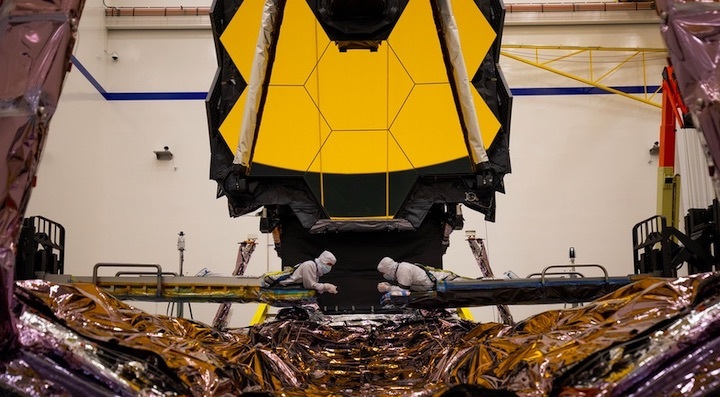
WASHINGTON — The head of NASA’s science directorate confirmed June 10 that the James Webb Space Telescope will miss its March 2021 launch date, a slip that was all but inevitable as the coronavirus pandemic slowed work on the spacecraft.
In a presentation to an online meeting of the Space Studies Board of the National Academies, Thomas Zurbuchen, NASA associate administrator for science, said that work on JWST had been going well in months before the pandemic but that the slowdown in work since March made it impossible to keep the mission on its previous schedule.
“We will not launch in March,” he said, which had been the target launch date for the mission. “That is not in the cards right now. It’s not because they did anything wrong.”
When NASA started closing its field centers in March because of the pandemic, personnel that had been overseeing integration and testing of the space telescope at a Northrop Grumman facility in Southern California returned home. Despite initial comments by NASA officials that work would be suspended entirely on the telescope, activities did continue there, including a test announced by NASA June 9 of its Deployable Tower Assembly that separates the mirror from the spacecraft bus.
That work, though, has been at a slower pace than before the pandemic. At a session of an American Astronomical Society meeting June 2, Jonathan Gardner, deputy senior project scientist for JWST at NASA’s Goddard Space Flight Center, said that Northrop at the time had five eight-hour shifts a week devoted to JWST work. Before the pandemic, the company had 12 shifts a week of 10 hours each.
Work had recently started to ramp back up on JWST, with some NASA personnel returning to the Northrop facility and the company preparing to resume a second daily shift. Nonetheless, Gardner said last week the project expected to miss that March 2021 launch date. “We’re expecting a delay,” he said.
NASA hasn’t set a new launch date yet for JWST. “What we need to do is learn the new efficiency” of working in current conditions, Zurbuchen said. “We need to calibrate that through a schedule review and go forward.” A schedule assessment, he said, was planned for July.
He remained hopeful that JWST will still launch some time in 2021 on an Ariane 5 from French Guiana. “I’m very optimistic of this thing getting off the launch pad in ’21.”
That confidence, he said, was based in part on the progress that the mission had been making just before the pandemic. There had been concerns about diminishing schedule reserves, including a Government Accountability Office report in January that warned a launch next March “may not be feasible” given the amount of work remaining and the rate at which the project was using up schedule reserves.
Zurbuchen said that the last quarterly review of JWST, held just before pandemic started shutting down NASA centers, showed that the project had completed all of its planned work in the previous quarter without using any schedule reserve. “Zero reserve days basically means that those teams stayed on their toes and pushed the telescope forward at the maximum speed possible,” he said.
JWST, though, had suffered years of launch delays and billions of dollars in cost overruns, most recently in 2018 when NASA announced the mission’s launch date, which had been October 2018 for several years before slipping the year before to early 2019, had been pushed back to March 2021 while its cost grew 10% to $8.8 billion.
Problems with JWST, along with issues early in the development of the next large astrophysics mission, recently renamed from the Wide-Field Infrared Survey Telescope (WFIRST) to the Nancy Grace Roman Space Telescope, have raised questions about NASA’s ability to manage large, or flagship, science missions. Zurbuchen said at the Space Studies Board meeting that flagship missions remain essential.
“NASA needs to do flagships. We need to learn how to do flagships,” he said, arguing such missions are often the only way to address pressing scientific questions. “The challenge with flagships has been, and we’re spending a lot of effort in learning about it, is to manage them in a way so that they don’t eat the neighborhood.”
Quelle: SN
----
Update: 18.06.2020
.
NASA says JWST won’t be ready for launch in March 2021
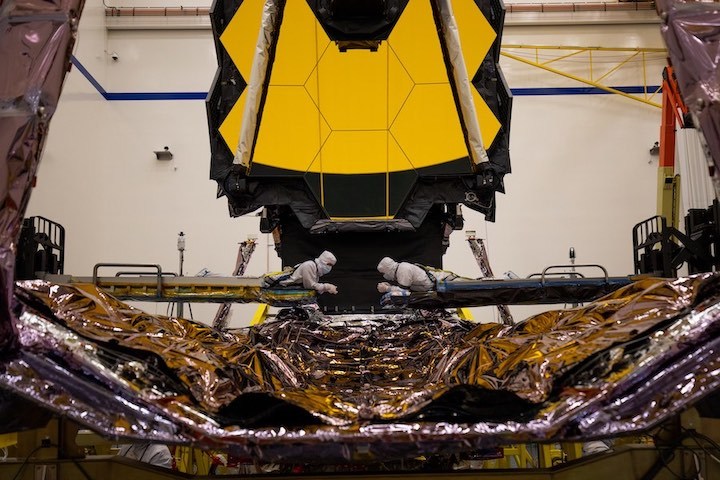
The launch of the James Webb Space Telescope will not happen in March 2021 — the mission’s previously-scheduled launch date — after the coronavirus pandemic forced a more than 50 percent reduction in staff levels at the observatory’s assembly and test facility.
The James Webb Space Telescope is the largest space science observatory ever built. The spacecraft and telescope are fully assembled inside a Northrop Grumman facility in Redondo Beach, California, but several test milestones remain before JWST is ready for shipment to its launch base in Kourou, French Guiana.
Testing of the James Webb Space Telescope has continued at a slower pace since the COVID-19 pandemic started impacting work schedules in March.
“Not everybody was available. There were positive cases here and there …We will not launch in March, absolutely will not launch in March,” said Thomas Zurbuchen, associate administrator of NASA’s science mission directorate. “That is not in the cards right now. It’s not because they did anything wrong. It’s just not going to be in the cards. It’s not a fault, or some mismanagement of some type.”
Zurbuchen added he is “very optimistic” that the observatory can still launch in 2021.
“There still is a lot of mountain to climb,” he said.
NASA engineers and oversight managers based at the Goddard Space Flight Center in Maryland, where the JWST project is managed, left the Northrop Grumman facility in California in March. That effectively stopped work on JWST’s optical telescope and instrument systems, which is NASA’s responsibility.
Northrop Grumman, the prime contractor for the JWST spacecraft and sunshield, was able to continue some work on the mission. But the progress was slower than planned.
“Northrop Grumman went from two shifts, six days a week, to one shift, five days a week, so operating at about 40 percent efficiency. So a big impact to James Webb Space Telescope,” said Steve Jurczyk, NASA’s associate administrator, in a June 9 presentation during a joint meeting of the National Academies’ Aeronautics and Space Engineering Board and the Space Studies Board.
In May, Northrop Grumman was able to test the extension of the observatory’s Deployable Tower Assembly, which will create a gap between JWST’s telescope and instrument compartment and the spacecraft bus. The extension of the tower assembly will allow the telescope and instruments, which are folded up during launch to fit inside the fairing of JWST’s Ariane 5 rocket, to be unfolded once in space and cooled to super-cold temperatures.
“Following augmented personal safety procedures due to COVID-19, the James Webb Space Telescope’s team in California continued integration and testing work with significantly reduced on-site personnel and shifts,” NASA said in a statement June 9. “The NASA/Northrop Grumman team recently resumed near-full operations.”

With NASA workers now back on-site at Northrop Grumman’s test facility in Southern California, Zurbuchen said that teams need to “learn the new efficiency” as technicians get used to working with physical distancing and other restrictions to reduce the risk of coronavirus transmission.
“We’re not through (with the coronavirus) at this point,” Zurbuchen said. “We will still have impacts.”
JWST had been scheduled for launch on an Ariane 5 rocket from French Guiana on March 30, 2021. The Ariane 5 launch is part of the European Space Agency’s contribution to the program.
Zurbuchen said NASA will convene a schedule review in July to assess the impacts to the JWST test schedule before setting a new launch date.
The mission is running years behind schedule, and it’s projected to cost billions of dollars more than NASA originally envisioned. JWST’s total cost to NASA was most recently projected to be $9.66 billion, and that figure does not include contributions from ESA and the Canadian Space Agency.
Teams working in Northrop Grumman’s spacecraft factory in Southern California connected the spacecraft and science modules of JWST last August, forming the complete observatory for the first time. With JWST fully assembled, engineers at Northrop Grumman — NASA’s prime contractor for the observatory — planned to put the craft through a series of deployment, electrical, vibration, and acoustic tests to ensure it will work as designed after launch.
The Webb telescope is the largest space-based observatory ever developed, with a primary mirror stretching 21.3 feet (6.5 meters) wide, comprised of 18 hexagonal segments made of beryllium and coated in gold. The mirror and JWST’s thermal sunshield will fold up origami-style to fit inside the nose shroud of its Ariane 5 launcher.
Scientists say the James Webb Space Telescope’s four infrared science instruments — which come from U.S., European and Canadian institutions — will see the very first stars and galaxies in the universe, observing light emitted some 13.5 billion years ago. With imaging power 100 times that of the Hubble Space Telescope, JWST will also peer into star-forming nebulas and collect data on the physical and chemical properties of planets around other stars.
Quelle: SN
----
Update: 27.06.2020
.
NASA expects to cover JWST launch slip with budget reserves
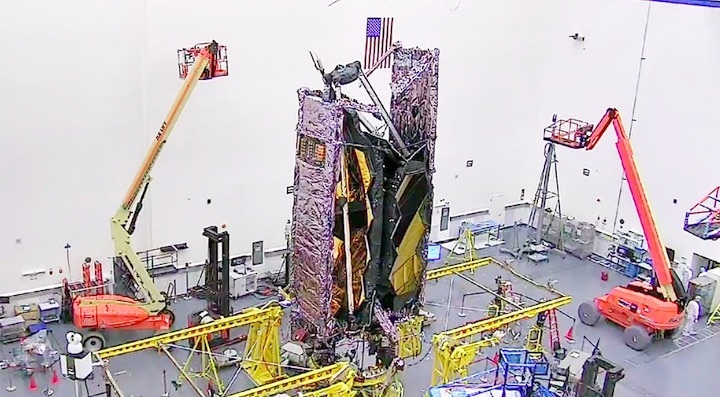
WASHINGTON — NASA hopes to keep the costs of additional delays in the James Webb Space Telescope within the program’s existing reserves and thus avoid asking Congress for additional funding.
At a June 24 meeting of NASA’s Astrophysics Advisory Committee, Eric Smith, program scientist for JWST at NASA Headquarters, said that while a new target launch date for the giant space telescope hasn’t been determined yet, the agency expected that the costs associated with that slip will be covered by existing budgetary reserves.
“The program has fiscal reserves, in addition to the schedule reserves, and right now we do not anticipate needing additional funding because we have money to pay for extra time in the schedule,” he said.
JWST exhausted its schedule reserve because of the slowdown in work caused by the coronavirus pandemic. The program still had nearly two months of schedule reserve when the pandemic caused work to briefly halt in March, then continue at a slower pace. Thomas Zurbuchen, NASA associate administrator for science, said June 10 that because of that slowdown, the mission will not make its March 2021 launch date.
Smith said NASA expects to set a new launch date in July after completing reviews, including examining how changes in work procedures required by social distancing protocols affect the remaining activities. “What has changed is the efficiency in which those tasks can be completed,” he said. That may include, he said, adding more schedule reserve beyond the two months that the program had in March.
He did not estimate how much the launch date will slip, but it is likely to be at least a few months. Before the pandemic slowed work on JWST, NASA was planning to put the telescope through a final series of acoustics and vibration tests in May and June. Smith said those tests are now scheduled for August.
Smith declined to say how much budget reserve the mission has remaining. “We can go a few months, several months past the March [2021] date and still have reserves to cover that,” he said.
JWST has a cost cap of $8.8 billion set by Congress after the mission’s previous schedule slip in 2018. Schedule overruns alone don’t require congressional approval, Smith said, but cost increases that exceed the cap would require reauthorization.
SOFIA cancels Southern Hemisphere campaign
Another NASA astrophysics mission affected by the pandemic, the Stratospheric Observatory for Infrared Astronomy (SOFIA), has canceled a planned deployment of the airborne observatory to New Zealand because of the pandemic.
In a June 23 presentation at the committee meeting, Naseem Rangwala, SOFIA project scientist, said the project worked for weeks on a way to carry out that observing campaign within the restrictions imposed by the pandemic, but ultimately concluded it was not feasible.
“The logistical, personnel and travel-related challenges remained, and we made a very difficult decision to cancel the 2020 New Zealand deployment,” she said. The project has for several years carried out such deployments, typically in the Northern Hemisphere summer, to conduct observations of celestial objects visible only from Southern Hemisphere skies.
She said the project worked with the New Zealand government and the U.S. Embassy in New Zealand on ways to carry out the campaign given the country’s restrictions on international travel, including a 14-day quarantine on any arrivals. Those restrictions have eradicated COVID-19 in the country, but ultimately were too much to overcome for SOFIA.
SOFIA, a Boeing 747 equipped with a 2.5-meter infrared telescope, has been grounded since March because of safety restrictions imposed in response to the pandemic. Earlier this month, project officials expressed optimism about resuming flights as soon as late June.
Those plans, which will require the approval of NASA, are still being developed, Rangwala said, using some of the planning that went into the canceled New Zealand campaign. “The project developed detailed plans and protocols for how to safely operate SOFIA within COVID-19 constraints,” she said.
She said the project now hopes to resume flights in mid-July from California. “We are making very good progress on getting the observatory returned to science flights,” she said.
SOFIA’s shutdown during the pandemic comes as the mission faces the threat of cancellation in the agency’s fiscal year 2021 budget proposal, as well as efforts to improve the efficiency and scientific output of the observatory. That has included canceling an instrument that was under development for SOFIA called the High Resolution Mid-infrared Spectrometer, or HIRMES.
“The HIRMES project was over-budget and over-schedule,” said Paul Hertz, director of NASA’s astrophysics division, at the meeting. “They had unsolved technology problems and could not produce a believable plan to complete within a predictable amount of money, so we terminated the project for its overruns.”
Work on HIRMES-related technology will continue, he said, but will be funded by a technology development program and not the SOFIA project.
Quelle: SN
----
Update: 17.07.2020
.
NASA to Provide Update on James Webb Space Telescope
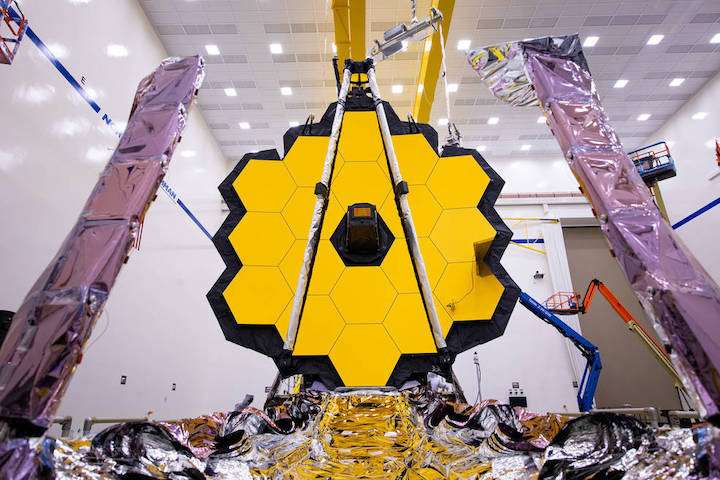
NASA will host a media teleconference at 4:30 p.m. EDT Thursday, July 16, to provide an update on the status of the agency’s James Webb Space Telescope, the world’s next premier infrared space observatory and the largest, most complex space telescope for astronomy ever built.
The media teleconference audio will stream live at:
Participants in the teleconference include:
- Stephen Jurczyk, NASA associate administrator
- Thomas Zurbuchen, NASA Science Mission Directorate associate administrator
- Gregory Robinson, NASA Webb program director
- Eric Smith, NASA Webb program scientist
To participate, media must email their name and affiliation to Felicia Chou at felicia.chou@nasa.gov by noon EDT Thursday, July 16.
Once deployed, Webb will help solve mysteries in our solar system and look beyond to distant worlds around other stars, as well as probe the mysterious structures and origins of our universe. Webb is an international program led by NASA with its partners ESA (European Space Agency) and the Canadian Space Agency.
Quelle: NASA
----
Update: 14.08.2020
.
NASA’s Webb Telescope is an International Endeavor
The James Webb Space Telescope is an international endeavor with widespread global contributions and experts in more than a dozen countries dedicated to the build, launch, and future science of this flagship NASA space observatory. The cooperation and collaboration on Webb is an incredible testament to what is possible with worldwide teamwork.
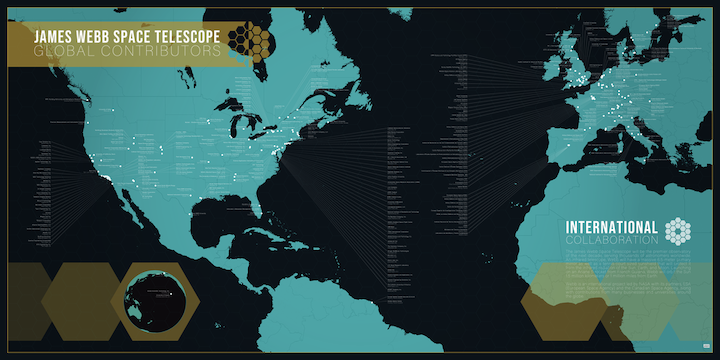
Thousands of scientists, engineers, and technicians from 14 countries, 29 U.S. states, and Washington, D.C. contributed to build, test, and integrate Webb. In total, 258 distinct companies, agencies, and universities participated – 142 from the United States, 104 from 12 European nations, and 12 from Canada.
“The Webb international partnerships are the perfect example of what can be accomplished when we, as a human race, work together to attain a common goal,” said Bill Ochs, the Webb project manager at NASA’s Goddard Space Flight Center in Greenbelt, Maryland. “When Webb launches, it will truly be a telescope for the world.”
As another element of international collaboration, Webb will launch in 2021 onboard an Ariane 5 rocket from the European Spaceport located near Kourou, French Guiana, on the northeast coast of South America.
Once in orbit, scientists will use Webb to conduct cutting-edge research on the cosmos. Webb will be a general-purpose observatory, meaning that competitively selected proposals from scientists around the world will be used to develop Webb’s observing plans. For more on the Webb science proposal process, please see http://www.stsci.edu/jwst/science-planning.
“Webb is a tremendous feat of engineering, built through the collaborative work and great dedication of a vast international community,” said Gregory L. Robinson, the Webb program director at NASA Headquarters in Washington, D.C. "Once launched, astronomers worldwide will be able to study the world-class science it will deliver and give us a broader understanding of the origins of our universe, inspiring future generations."
Built and available for use by an international consortium, Webb will serve astronomers worldwide. In an effort to cross language barriers and connect Webb to all people, top facts about Webb were translated into 44 languages. For more on the Webb Language Cards, please see https://jwst.nasa.gov/content/features/keyFactsInternational/.
The James Webb Space Telescope will be the world’s premier space science observatory when it launches in 2021. Webb will solve mysteries in our solar system, look beyond to distant worlds around other stars, and probe the mysterious structures and origins of our universe and our place in it. Webb is an international program led by NASA with its partners, ESA (European Space Agency) and the Canadian Space Agency.
Quelle: NASA
----
Update: 27.08.2020
.
James Webb passes critical test as telescope moves toward 2021 launch
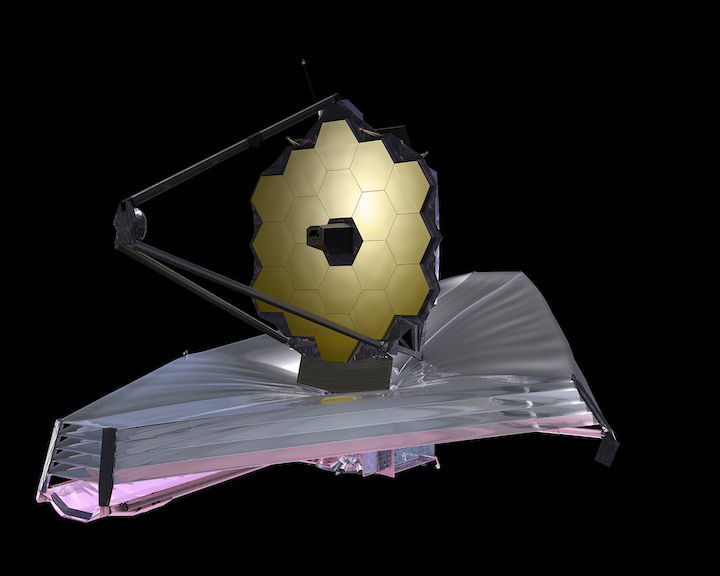
The James Webb Space Telescope — a collaboration between NASA, the European Space Agency (ESA), and the Canadian Space Agency (CSA) — has successfully completed a critical pre-flight milestone and test that paves the way for continued final testing of the most complex telescope ever built.
At present, James Webb remains on track for a launch from the Guiana Space Centre in Kourou, French Guiana, on an Ariane 5 rocket No Earlier Than 31 October 2021.
The three-way partnership between NASA, ESA, and CSA, follows large-scale, international partnerships for space-based telescopes of the past and results in sharing of the financial output as well as economic and scientific benefits the mission offers.
For the James Webb Space Telescope (JWST), ESA’s primary contribution from a monetary standpoint to the mission was procurement of the launch vehicle, in this case the ESA-built and Arianespace operated Ariane 5 rocket.
This type of monetary service in relation to providing a launch vehicle is a fairly standard interagency operating procedure; the last time such an agreement occurred was between ESA and NASA for the Solar Orbiter mission in February 2020, to which NASA was a partner and bought the launch vehicle: an Atlas V 411 from United Launch Alliance.
In addition to the launch vehicle, ESA is also providing monetary support for the NIRSpec instrument, funding for the Optical Bench Assembly of the MIRI instrument, as well as staff to the Space Telescope Science Institute in Baltimore, Maryland, USA, to help carry out the mission once the telescope is launched.
The other major international partner is the Canadian Space Agency, which has provided the Fine Guidance Sensor, which will be used to point and focus the telescope on observational targets, and the Near-Infrared Imager and Slitless Spectrograph for the study of exoplanets and distant galaxies.
This partnership ensures ESA and CSA receive guaranteed observation time on the telescope and are one of the first agencies along with NASA to study the data collected by the most advanced observatory ever built.
Moreover, selection of scientific targets will be a joint effort between NASA, ESA, and CSA, while scientists at large will propose objects of interest as well that may not appear on the list of primary targets identified by the three agencies.
The ability to launch this mission took another major leap forward last week with critical ground segment testing, which marked the first time commands to power up and test JWST’s scientific instruments were sent to the fully assembled observatory.
The commands were issued — as they will be during the mission — from the Mission Operations Center at the Space Telescope Science Institute in Baltimore, Maryland. Those commands will then be routed to the telescope through the Deep Space Network (DSN) of communication dishes located in Barstow, California, USA; Canberra, Australia; and Madrid, Spain.
Because the actual DSN dishes can only communicate with objects in space, teams used a DSN network emulator — standard procedure for missions that will have to communicate through the network — for the test.
The main purpose of this evaluation was to ensure all four primary instruments functioned as designed and that the telescope was not only able to receive and execute commands from the ground but to downlink data back as well.
“This was the first time we have done this with both the actual Webb flight hardware and ground system,” said Amanda Arvai, Deputy Division Head of Mission Operations at the Space Telescope Science Institute in Maryland.
“We’ve performed pieces of this test as the observatory was being assembled, but this is the first ever, and fully successful, end-to-end operation of the observatory and ground segment. This is a big milestone for the project, and very rewarding to see Webb working as expected.”
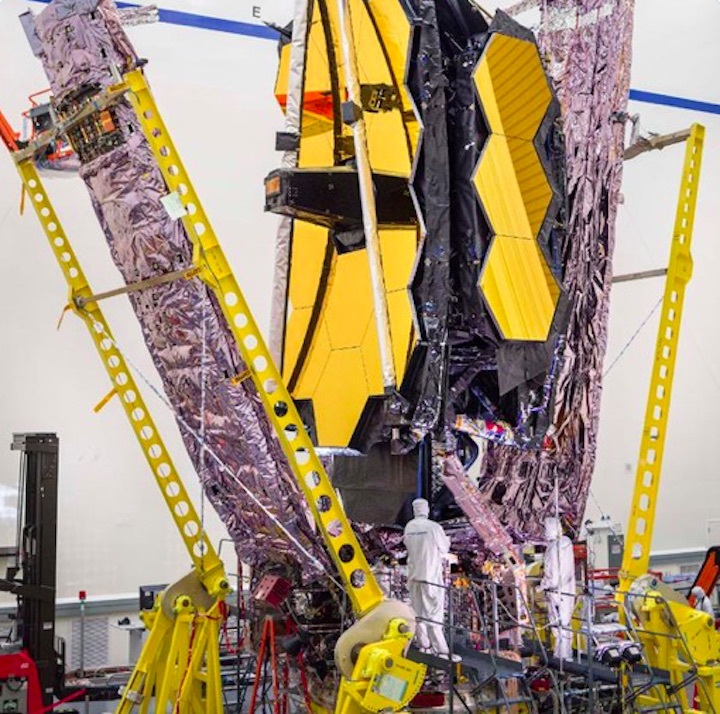
The test lasted four days and took place from both the Space Telescope Science Institute and the cleanroom where James Webb is undergoing final assembly at Northrop Grumman’s Redondo Beach, California, facility.
“This was also the first time we’ve demonstrated the complete cycle for conducting observations with the observatory’s science instruments. This cycle [started] with the creation of an observation plan by the ground system which [was] uplinked to the observatory by the Flight Operations Team,” added Arvai.
“Webb’s science instruments then performed the observations and the data was transmitted back to the Mission Operations Center in Baltimore, where the science was processed and distributed to scientists.”
Speaking to the most recent round of tests, Dr. Eric Smith, James Webb Space Telescope Program Scientist, NASA Headquarters, noted in response to NASASpaceflight questions that, “Running commands from the operations center all the way through the Webb communications network AND getting back the responses we expected is an exciting milestone.”
“This complex system of computer software and commands, spacecraft electronics and communications networks worked beautifully. Anyone who’s ever written a computer program, or built something, can relate to the joy of seeing it do exactly what you wanted it to.”
Successful testing of the four primary scientific instruments came on the heels of acoustic testing that blasted James Webb with the same amount of sound and acoustic waves it will experience during launch next year.
Acoustic testing is yet another critical part of pre-flight preparations to ensure satellites can survive the sound environment imparted to them during launch, which is often the most stressful aspect of any mission not just for the satellite but for its control teams and scientists as well.

The James Webb Space Telescope in final integration earlier this year at Northrop Grumman’s Redondo Beach, CA, facility. (Credit: NASA/Chris Gunn)
What makes James Webb slightly unique in this regard is that the most stressful part of its mission will likely not be the launch to its intended location 1.5 million kilometers (1 million miles) from Earth at the L2 Lagrange point but rather its complex unfolding process thereafter.
A Lagrange point is a specific region of space around two large celestial bodies where the gravity of those two objects cancels each other out, providing a stable platform for observatories like the James Webb Space Telescope while keeping it the same distance from Earth.
Once in space, and due to its complex design, JWST must perform roughly 344 complex — no room for failure — unfolding operations. These events are all Category 1 failure points, meaning that if any single one does not unfold as designed, the entire mission will be rendered inoperable.
Because of that, great care is being taken to make sure all of those steps are working perfectly on the ground as JWST — unlike Hubble — was not built with human servicing missions in mind given the vast distance from Earth at which it will operate.
To this end, a major upcoming test for JWST is deployment and unfolding of its sunshield, communications arrays, and mirrors to verify that all deployments can occur successful.
Randy Pollema, electrical integration and testing lead for Webb at Northrop Grumman in Redondo Beach, added, “I’ve never seen such … collaboration and cross-organizational efforts to bring so many different teams and people in so many different areas together to execute a common goal so successfully.”
“We have a lot of pride, and feel a lot of personal reward in what we’ve been able to accomplish over the last year in assembling Webb into its final form, and with the completion of this latest systems evaluation we can confidently move forward knowing that the assembly was a success.”
Speaking to the overall importance of the mission and what they are personally most excited for, Dr. Smith told NASASpaceflight that “The commissioning or ‘try-out’ portion of the mission that happens after launch and lasts for six months leading to the normal operations of the mission [is something I’m personally really excited about].”
“This is the period when we ready the observatory for operations in space and has many critical events, but also long periods of waiting for conditions on the observatory (like temperature) to be just right before we can do anything. We’re working hard on how this will go, but it gets overshadowed by the great images of the observatory itself.”
Dr. Smith noted with pride that “This mission will demonstrate that NASA still does the nearly impossible and represents the pinnacle of government, industry and academic achievement.”
Quelle: NS
----
Update: 7.10.2020
.
NASA’s James Webb Space Telescope Completes Environmental Testing

With the completion of its latest series of milestone tests, NASA’s James Webb Space Telescope has now survived all of the harsh conditions associated with a rocket launch to space.
Webb’s recent tests have validated that the fully assembledobservatory will endure the deafening noise, and the jarring shakes, rattles and vibrations that the observatory will experience during liftoff. Known as “acoustic” and “sine-vibration” testing, NASA has worked carefully with its international partners to match Webb’s testing environment precisely to what Webb will experience both on launch day, and when operating in orbit.
Though each component of the telescope has been rigorously tested during development, demonstrating that the assembled flight hardware is able to safely pass through a simulated launch environment is a significant achievement for the mission. Completed in two separate facilities within Northrop Grumman’s Space Park in Redondo Beach, California, these tests represent Webb’s final two, in a long series of environmental tests before Webb is shipped to French Guiana for launch.
The next environment Webb will experience is space.
“The successful completion of our observatory environmental tests represent a monumental milestone in the march to launch. Environmental testing demonstrates Webb’s ability to survive the rocket ride to space, which is the most violent portion of its trip to orbit approximately a million miles from earth. The multinational group of individuals responsible for the execution of the acoustic and vibration test is composed of an outstanding and dedicated group of folks who are typical of the entire Webb team,” said Bill Ochs, Webb project manager for NASA Goddard Space Flight Center in Greenbelt, Maryland.
Testing began by first encapsulating the entire telescope in a mobile clean room built to shield it from the outside world. Technicians then carefully guided it to a nearby acoustic testing chamber where it was intentionally blasted by sound pressure levels above 140 decibels, with a spectrum tuned to the specific signature of the Ariane 5 rocket it will ride to space. During the tests nearly 600 individual channels of motion data were carefully observed and recorded. Typical acoustic and vibration tests measure approximately 100 channels of data, but the complex size and shape of the observatory required considerably more measurement to ensure success. The data was then thoroughly analyzed and marked as a complete success.
Upon successful completion of its final acoustics tests, Webb was again packed and transported to a separate facility to simulate the low frequency vibrations that occur during liftoff. While inside Webb was placed on a specialized shaker table capable of precise vertical and horizontal acceleration. Where acoustic testing simulates the high-frequency dynamics of launch, vibration testing covers the lower frequencies experienced. With the combination of the two the entire mechanical environment Webb will experience during launch is accounted for.
“The testing team is an international consortium of structural dynamics experts who are the lead engineers for each piece of hardware on the observatory. The team members are located throughout the USA and Europe, spanning across 9 time zones! They are extremely dedicated to support testing at all hours and days to provide their expertise,” said Sandra Irish, Webb Mechanical Systems Structures Engineer Lead for NASA’s Goddard Space Flight Center in Greenbelt, Maryland. “Through the team’s dedication, hard work, and just pure excitement in being a part of this complex test, it was a complete success! I have known these individuals for many years and it’s been an honor to work with each one of them.”
Webb is now scheduled to move forward into the last full extension of its iconic primary mirror and sunshield followed by a full systems evaluation before being encapsulated in a specialized shipping container for transport to South America. Deploying the observatory after experiencing a simulated launch environment is the best way to replicate the true series of events the observatory will experience during launch, and when performing its complex deployment sequence in space. Initial analysis suggests the observatory passed through observatory level acoustic and vibration testing successfully, but the full verification of flight worthiness will occur after Webb has successfully completed final deployment tests.
Engineers and technicians continue to follow augmented personal safety procedures due to the COVID-19 situation, which is causing significant impact and disruption globally. The team has resumed near-full operations and are now preparing for the final phase of testing prior to shipment to the launch site.
The James Webb Space Telescope is the world’s largest, most powerful, and complex space science telescope ever built. In addition to the groundbreaking science expected from it after launch, Webb has required an improvement in the testing infrastructure and processes involved in validating large complex spacecraft for a life in space. Various facilities around the country had to be enlarged and upgraded to confidently test and prepare a machine as large as Webb for liftoff. Lessons learned from previous space telescope development were invested into Webb, and future space telescopes will be built upon the same collective knowledge. Thousands of scientists, engineers, and technicians contributed to build, test, and integrate Webb. In total, 258 companies, agencies, and universities participated – 142 from the United States, 104 from 12 European nations, and 12 from Canada.
Webb is NASA’s next great space science observatory, which will help in solving the mysteries of our solar system, looking beyond to distant worlds around other stars, and probing the mystifying structures and origins of our universe. Webb is an international program led by NASA, along with its partners ESA (European Space Agency) and the Canadian Space Agency.
Quelle: NASA
----
Update: 13.10.2020
.
Milestone marks final acoustic and sine-vibration tests for NASA’s next flagship space observatory before its historic launch next year
Northrop Grumman Corporation (NYSE: NOC) and NASA have completed environmental testing on the James Webb Space Telescope.
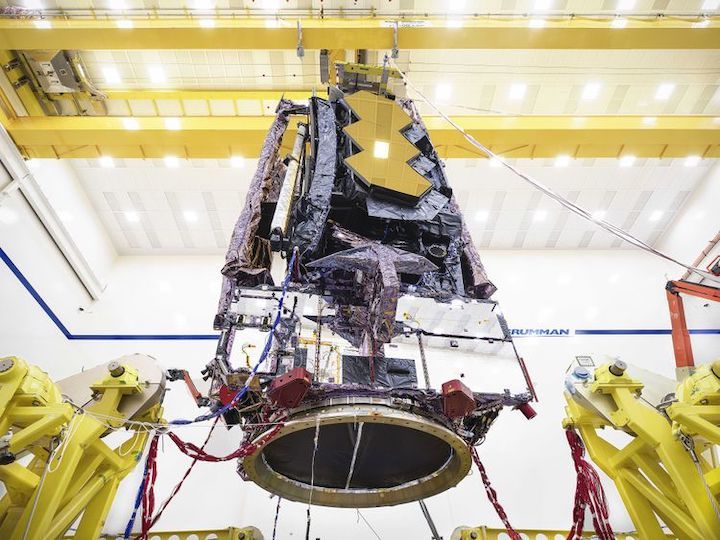
The environmental testing demonstrated Webb’s ability to withstand harsh environmental characteristics during its upcoming rocket launch and journey to reach its orbit at the second Sun-Earth Lagrange point (L2), approximately one million miles away from Earth.
“The completion of environmental testing is a major step forward in our preparations for Webb’s historic launch and a testament to the remarkable dedication of the team,” said Scott Willoughby, vice president and program manager, James Webb Space Telescope, Northrop Grumman.
Webb’s environmental testing consisted of a series of rigorous acoustic and sine-vibration tests spanning several weeks. Webb was first placed in Northrop Grumman’s acoustic testing chamber where it underwent high frequency oscillating sound pressure levels above 140 decibels to simulate the effects of being launched on a rocket. The completion of the acoustic tests and analysis validated that Webb’s hardware, science instruments, structure and electronics can successfully survive the planned rocket launch in a simulated environment.
Following the completion of acoustic testing, Webb transitioned to a separate chamber where it underwent a series of sine-vibration tests on a shaker table to simulate vertical and horizontal accelerations in lower frequencies. The observatory was rigorously exposed to vibration levels on the shaker that are well above the flight environment, exciting its resonances to demonstrate its capability to withstand the flight environment with significant margins.
The next series of major milestones for Webb will require NASA and Northrop Grumman engineers and technicians to deploy the observatory’s five-layered sunshield followed by wing deployments of its primary mirror in order to fully verify Webb’s flight worthiness. Lastly, Webb will undergo a full systems evaluation before it begins preparations for its historic journey to Kourou, French Guiana for its October 2021 launch.
Northrop Grumman leads the industry team for NASA’s James Webb Space Telescope, the largest, most complex and powerful space telescope ever built. NASA leads an international partnership that includes the European Space Agency and the Canadian Space Agency. Goddard Space Flight Center manages the Webb Telescope project, and the Space Telescope Science Institute is responsible for science and mission operations, as well as ground station development.
Northrop Grumman solves the toughest problems in space, aeronautics, defense and cyberspace to meet the ever evolving needs of our customers worldwide. Our 90,000 employees define possible every day using science, technology and engineering to create and deliver advanced systems, products and services.
Quelle: Northrop Grumman

